Dehong Dai and Jingpo Autonomous Prefecture
The Dehong Dai and Jingpo Autonomous Prefecture is located in western Yunnan province, People's Republic of China, and is one of the eight autonomous prefectures of the province, bordering Baoshan to the east and Burma's Kachin State to the west.
Dehong Prefecture 德宏州 | |
|---|---|
| Dehong Dai and Jingpo Autonomous Prefecture 德宏傣族景颇族自治州 | |
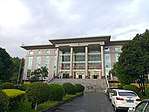 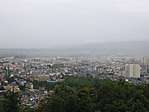 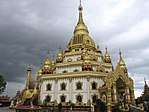 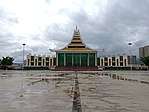 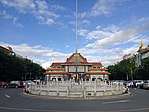 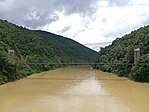 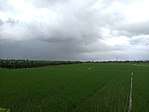 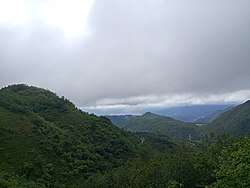 From top, left to right: Dehong Prefecture government hall, skyline of Mangshi, Menghuan Pagoda, Mangshi Square with China-Myanmar Friendship Memorial Hall, Ruili Border Port, Shweli River, farm in Ruili, mountains in Mangshi | |
| Etymology: Tai Nuea language (ᥖᥬᥲ ᥑᥨᥒᥰ), meaning "the lower reaches of the Nu River" | |
| Nickname(s): hometown of peafowl | |
 Dehong in Yunnan | |
| Coordinates (Dehong Prefecture government): 24°25′59″N 98°35′08″E | |
| Country | People's Republic of China |
| Province | Yunnan |
| Founded | 24 July 1953 |
| Seat | Mangshi |
| Divisions | |
| Government | |
| • Prefecture governor | Wei Gang (卫岗)[1] (CPC) |
| • Secretary of CPC Prefecture Committee | Wang Junqiang (王俊强)[2] |
| Area [3]:536 | |
| • Total | 11,172.24 km2 (4,313.63 sq mi) |
| Area rank | 16 |
| Dimensions [4]:97 | |
| • Length | 170 km (110 mi) |
| • Width | 122 km (76 mi) |
| Elevation | 920 m (3,020 ft) |
| Highest elevation | 3,404.6 m (11,169.9 ft) |
| Lowest elevation | 210 m (690 ft) |
| Population | |
| • Total | 1,211,440 |
| • Estimate (2016)[6]:38 | 1,294,000 |
| • Rank | 13 |
| • Density | 110/km2 (280/sq mi) |
| • Density rank | 9 |
| Ethnics [6]:38 | |
| • Han Chinese | 704,000 - 52.24% |
| • Dai | 368,100 - 28.45% |
| • Jingpo | 141,200 - 10.91% |
| • Lisu | 33,400 - 2.58% |
| • Achang | 32,100 - 2.48% |
| • Palaung (De'ang) | 15,200 - 1.17% |
| Sex [5]:101–160 | |
| • male | 624,774 - 51.57% |
| • female | 586,666 - 48.43% |
| Time zone | UTC+8 |
| Postal code | |
| Area code(s) | (0)692 |
| ISO 3166 code | CN-YN-31 |
| Vehicle registration | 云N |
| Website | www |
| Dehong Dai and Jingpo Autonomous Prefecture | |||||||
|---|---|---|---|---|---|---|---|
| Chinese name | |||||||
| Simplified Chinese | 德宏傣族景颇族自治州 | ||||||
| Traditional Chinese | 德宏傣族景頗族自治州 | ||||||
| |||||||
| Burmese name | |||||||
| Burmese | တယ်ဟုန် ရှမ်း နှင့် ဂျိမ်းဖော ကိုယ်ပိုင်အုပ်ချုပ်ခွင့်ရ စီရင်စု | ||||||
| Tai Nuea name | |||||||
| Tai Nuea | ᥟᥪᥒᥱ ᥙᥪᥴ ᥓᥝᥲ ᥙᥩᥒ ᥛᥥᥝᥰ ᥖᥭᥰ ᥓᥤᥒ ᥚᥨᥲ ᥖᥬᥲ ᥑᥨᥒᥰ | ||||||
| Jingpho name | |||||||
| Jingpho | Sakhkung Sam Jinghpo Amyu Madu Uphkang Mungdo | ||||||
| Zaiwa name | |||||||
| Zaiwa | Sikung Sam Zaizo Byumyu Yumsing Upkang Mau | ||||||
Etymology
Tai Nuea is the origin language of the word "Dehong", in Tai Le script (the script used to write the Tai Nüa language by the Tai Nua people) is written as "ᥖᥬᥳ ᥑᥨᥒᥰ", which transliterates to Latin as "Taue Xoong". Dehong means the lower reaches of the Nu River.[7]:38
However, the Mandarin characters for Dehong is "德宏. These two character are compound of 德 "moral, value" and 宏 "magnificent, great, macro". Thus, from Mandarin Chinese point of view, 德宏 (Dehong) means "moral" + "magnificent" thus it has means "magnificent (great) moral (value)"
History
Early history
Dianyue and Ailao were the ancient countries recorded in Chinese literature in Dehong area, and Guozhanbi (Kawsampi) was an ancient country established by Dai people and recorded in Dai legend.
Dianyue
In the history book Records of the Grand Historian written by Sima Qian during the Han dynasty, a paragraph in volume 123 describes Dianyue as when Zhang Qian visited Daxia in Central Asia, he found some merchandise was produced in Sichuan. And the Daxia merchant said it was purchased from Yuandu (India). There was a trade route, Shu-Yuandu Road (蜀身毒道) between Yuandu and Sichuan. The road passed a kingdom named "Dianyue" (滇越).[8] The country is also called "Dianyue Chengxiang" (滇越乘象国) in modern books.[6]:37Chinese historians generally said Tengyue is the center of Dianyue Chengxiang, and the territory included the Dehong area. But, some historians disagree with this opinion. Lou Zichang believes Dianyue Chengxiang was not a country in western Yunnan, even not a country established by Dai people.[9]
Ailao
Ai Lao (哀牢) is an ancient tribal alliance country in west of Yunnan during Spring and Autumn to Eastern Han period, and modern historians said the area include Dehong. In Chronicles of Huayang, the record of Ailao mentions its territory "3,000 li from west to east, and 4,600 li from south to north",[10] approximately equal to 1,300 km west to east and 1,994 km south to north in modern unit.[11] It includes the southwest of Yunnan and most of Myanmar, in modern research, it is called the generalized area of Ailao.[11]
In the Han period, Ailao was an influential tribal country with a population of 20,000.[11] Baoshan historian, Xiao Zhengwei believes the kingdom of Dianyue was a powerful tribe under Ailao.[12]
In 69 AD, Liu Mao (柳貌), the king of Ailao, led the tribal alliance to surrender to the Han dynasty, and Han set "Ailao County" here.[13] In Southern dynasty Qi period, the name was changed to "Xicheng County" (西城县).[14]:1950 During the end of the Liang dynasty, Xicheng County was abolished.[14]:933
Guozhanbi
Between 568 BC and 424 BC, during the Eastern Zhou dynasty in China, ancestors of Dai people had settled in Shweli River valley area and entered the tribal period. In 364 BC, grand chief Gelaba (葛拉叭) unified the tribes in Shweli basin. He became the chief of the tribal alliance and set the capital at Hansa (喊萨, in modern Ruili). It was the early stage of the kingdom "Guozhanbi"(果占璧), also called "Kawsampi" (憍赏弥).
In 364 AD, a descendant of Gelaba named Zhaowuding (召武定) inherited the throne. He became the famous deity, sovereign, and culture hero of Dai people.[15]:5 In the 7th century, the Dai area was in chaos and the descendants of Zhaowuding could not effectively control the area. At the same time, the kingdom of Nanzhao was rising, and conquered the Dehong area. Piluoge, the king of Nanzhao canonized another Dai tribe chief Hundeng (混等) to be the "King of Mong Mao" and managed the whole Dai area in 762.[16]:28–29
In 1995, Dehong historian Yang Yongsheng published research on ancient Dai civilization. He put forward a new opinion during the Dai legend research - The "Kingdom of Daguang" (达光) is the first country of Dai people which was established in 424 BC, and the country "Dianyue Chengxiang" is another name of "Daguang". In 233 BC, the capital of Daguang moved to Pagan, and finally perished in 586 AD.[17] The research was countered by He Ping, a history professor at Yunnan University. He Ping says that the Kingdom of Daguang is the legendary kingdom of Tagaung in Burmese history and there was no kingdom of "Daguang" in the ancient Dai civilization. The Dai legend of Daguang is the story of pre-period of Pyu city-states. The story of Pyu city-states spread to Dehong Dai area, localized to a Dai legend and was recorded in Dai literature.[18]
In Yang Yongsheng's research, the kingdom of "Guozhanbi" was the second kingdom established by Dai people after Daguang. Dai languages literatures were his sources of research. He said the kingdom of Guozhanbi was existence from 567 to 1488. According to the research of He Ping, "Guozhanbi" is the ancient state "Kawsampi" or Kosambi. There are many of legends about Kawsampi in Thai-Shan folks culture. The origin of the legend was a story in Buddhist texts. Therefore, He Ping thought the Kingdom of "Guozhanbi" or "Kawsampi" is untrustworthy history.[19]
Medieval
Whether or not the early history of Dehong is controversial, it can be determined that Dehong belonged to Nanzhao and Dali in the medieval period of Yunnan. In Nanzhao, it was separated to "Yongchang Jiedu" (永昌节度, south of Dehong) and "Lishui Jiedu" (丽水节度, north of Dehong).[4]:10 In Dali, it was under the division of "Zhenxi Zhen" (镇西镇).[20]:115
In 1253, Kublai Khan conquered the Dali Kingdom, Dehong Dai people capitulated to the Mongol Empire. The Mongols set an administrative division named "Jinchi Anfu Si" (金齿安抚司) to manage west of Yunnan. In 1276, Yuan dynasty, the Anfu Si was upgraded to "Jinchi Xuanfu Si" (金齿宣抚司), and set an agency "6 Lu governor Fu" (六路总管府) to manage the Dehong area. The 6 Lu were: Luchuan Lu (麓川路, modern Ruili and Longchuan), Pingmian Lu (平缅路, modern southern Lianghe and northern Longchuan), Zhenxi Lu (镇西路, modern Yingjiang), Zhenkang Lu (镇康路, modern Zhenkang, out of Dehong), Mangshi Lu (茫施路, modern Mangshi) and Rouyuan Lu (柔远路, modern Lujiang, out of Dehong). In addition, a special division named "Nan Dan" (南赕) and Nandian Fu (南甸府, modern Lianghe) was set. The scope of "6 Lu general manager Fu" is closed to the modern Dehong territory.[4]:11
In 1277, Narathihapate, the king of Burmese Pagan Kingdom, invaded modern Dehong area. The Battle of Ngasaunggyan occurred on the bank of Taping River, presently in the Yingjiang County. The Yuan army only had 700 soldiers but finally repelled Burmese military of 40,000 to 50,000 soldiers with 10,000 horses and 800 elephants.[21]:104 It was the prelude to the First Mongol invasion of Burma.[22]:26–27
During the 13th and 14th century, the Dehong Dai people immigrated to modern Assam in India and built up the kingdom of Ahom. They formed the latter-day Ahom people.[23]
Mong Mao
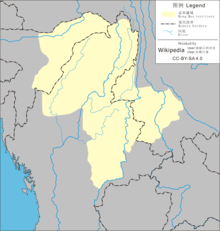
Local Dai chief was the leader of Luchuan Lu and they were the successors of "Guozhanbi". "Luchuan" is the name denoted by Yuan, and "Mong Mao" is self claim name.[24]
Si Kefa enthroned the chieftain of Luchuan Lu in 1340[25] and sent troops to surrounding state such Hsenwi, Mongyang, Mongmit. After that, he attacked Mangshi, Zhenxi, Pingmian, and Nandian. Yuan dynasty initiated wars in 1342, 1345, 1346, and 1347 to counterattack Luchuan, but all attempts failed. Luchuan conquered the surrounding states successively. In 1355, Si Kefa requested Yuan dynasty to canonize him. Yuan central government admitted his local regime and canonized Si Kefa to be the first Mong Mao Tusi. The central government set a division of "Pingmian Xuanwei Si" (平缅宣慰司) at Mong Mao to legalize the regime, and Mong Mao Tusi is the leader of Xuanwei Si.[15]:9–10
In 1382, the Ming dynasty military arrived at the Mong Mao Tusi and Si Lunfa surrendered. Ming granted him the title "Xuanwei Commissioner of Luchuan Pingmian" (麓川平缅宣慰使) and changed the division name "Luchuan Pingmian Xuanwei Si". In 1385, the leader of Jingdong renegaded the Mong Mao regime, and Si Lunfa sent troops to attack Jingdong.[26] But, Mu Ying, the general of Yunnan was protecting Jingdong leader.
The wars between Mong Mao regime and Yunnan local government occurred in 1387 and 1388. Finally, Mong Mao failed. In order to maintain the relationship with Ming, Si Lunfa sent a mission to Kunming to make peace. Mong Mao consented to compensate for the losses, and peace was restored.
After Si Lunfa died in 1399, a minister of Mong Mao launched a rebellion. The Ming government felt threatened and separated 14 Tusi regions from the Luchuan territory.[15]:11–13 During Si Xingfa's ruling in the 1410s, the Mong Mao territory decreased to include only modern Ruili, Mangshi and Namhkam.[27]
After Si Xingfa, Si Renfa was enthroned in 1413, he tried to restore the kingdom to its former glory. In 1439, a conflict between Mong Mao and Ming reoccurred. This was the beginning of Luchuan–Pingmian campaigns. In 1441, Ming sent troops to Mong Mao, and Si Renfa fled to Mongyang. Several wars occurred between 1443 and 1449, finally Mong Mao lost Dehong. The imperial family continued to live in Mongyang until they were attacked in 1604 by the Toungoo dynasty.[15]:13–16
Ming and Qing dynasties


After Mong Mao kingdom declined, Chinese central government gained efficient control in the Dehong area. During Ming and Qing dynasties, central government canonized 10 Tusi in Dehong:[15]
| Tusi | established | title | family name | modern |
|---|---|---|---|---|
| Mong Mao | 1604[28]:80 | Mongmao Anfu Si 勐卯安抚司 |
Kan (衎) | Ruili |
| Longchuan | 1444[29]:44 | Longchuan Xuanfu Si 陇川宣抚司 |
Duo (多) | Longchuan |
| Nandian | 1444[30]:73 | Nandian Xuanfu Si 南甸宣抚司 |
Dao (刀) Gong (龚) |
Lianghe |
| Ganya | 1403[31]:91 | Ganya Zhangguan Si 干崖长官司 (1403-1444) Ganya Xuanfu Si 干崖宣抚司 (1444-1955) |
Dao (刀) | Yingjiang |
| Mangshih | 1443[32]:21 | Mangshi Yuyi Zhangguan Si 芒市御夷长官司 (1443-1640) Mangshi Anfu Si 芒市安抚司 (1640-1950) |
Fang (放→方) | Mangshi |
| Zhanda | Chongzhen period[15]:180 | Zhanda Vice Xuanfu Si 盏达副宣抚司 |
Si (思) | Yingjiang |
| Zhefang | 1584[32]:21 | Zhefang Vice Xuanfu Si 遮放副宣抚司 |
Duo (多) | Mangshi |
| Husa | 1770[15]:227 | Husa Zhangguan Si 户撒长官司 |
Lai (赖) | Longchuan |
| Lasa | 1653[15]:240 | Lasa Zhangguan Si 腊撒长官司 |
Gai (盖) | Longchuan |
| Mengban | 1899[32]:21 | Mengban Tu Qianzong 勐板土千总 |
Jiang (蒋) | Mangshi |
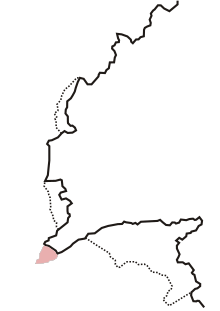
During the Ming dynasty, Sino-Burmese wars occurred twice in Dehong.[4]:18–19 In 1594, Yunnan grand coordinator Chen Yongbin (陈用宾) built up 8 border defense military checkpoints to guard international border between Dehong and Burmese Toungoo dynasty; these checkpoints formed the early borders between China and Myanmar.[33]
In 1658, the last emperor of Southern Ming dynasty , Zhu Youlang, passed the Nandian and Ganya Tusi and fled to Myanmar. He granted Ganya Tusi a marquess title. Ganya Tusi helped Youlang to flee but was completely annihilated in the tussle. Thereafter, all the Tusi in Dehong surrendered to the Qing dynasty in 1659. The war between Qing and Konbaung dynasty during 1765 to 1769 also extended to Dehong area.[4]:19–21
In 1875, a British translator, Augustus Raymond Margary, and his four personal staffs were murdered in west of Yingjiang County. This was an important non-governmental crisis in Sino-British relations and came to be known as the "Margary Affair". This event was followed by the signing of the Yantai Treaty.[4]:22
In 1894, during a Britain-China border convention,[Note 1] certain sections of the China–Myanmar border to the south of the "High Conical Peak"(尖高山) were delimited ,[34]:192 and an agreement was reached that the Qing dynasty should open two border ports between Burma and China: Manyun (蛮允) and Zhanxi (盏西).[35]:578 [4]:23
In 1897, another agreement was signed,[Note 2] three parts of the area around Dehong were incorporated into Burma although the convention in 1894 had determined they were part of China,[34]:190 and four of the border checkpoints which established by Chen Yongbin in Ming dynasty were also incorporated into Burma.[4]:23 In this agreement, the British government leased the "Namwan Assigned Tract", also called "Meng-Mao triangular area" in southwest of Dehong with the rent of 1,000 Rupee a year.[34]:194 Finally, China didn't receive back this region and used it to exchange another area in west of Cangyuan in 1960.[36]
After Qing dynasty
After Wuchang Uprising occurred in October 1911, Ganya Tusi Dao Anren (刀安仁) launched an uprising at Tengyue on 27 October 1911. Under the Republic of China, the Yunnan government tried to perish Tusi system and replace Tusi with state-appointed officials, but the Tusi officials opposed the change. Therefore, special administrative divisions were formed to support the period of transition. The administrative titles include Suppress Committee (弹压委员) and Deputy County (县佐) between 1911 and 1917, District and Deputy County between 1917 and 1932, and Administrative Bureau (设治局) after 1932.
The Tusi system existed until the land reform movement in 1955. The Administrative Bureaus after 1932 included Luxi, Ruili, Longchuan, Yingjiang, Lianshan, and Lianghe - they were the predecessor of future counties.[4]:24–25
During the World War II, Dehong was an important strategic location for China. By 1938, the Burma Road was built and it was an important international transit channel after Japanese army blocked the eastern coast of China.[37] In 1939, Central Aircraft Manufacturing Company moved to Loiwing in south-west corner or Ruili, and it was the biggest aircraft manufacturing plant of China at that time.[38]
After World War II
The area was declared an autonomous region in 1953. In May 1956, it became an autonomous prefecture. In 1960, when inter-provincial migration took place many farmers came to Yunnan to farm bananas. This was during the "Great Leap Forward" when a biologist working for Mao Zedong wrote an article about the weather in Yunnan being very suitable for bananas to be planted. Before this, many Chinese were scared of going there because of an illness that lurked about. It was later discovered that this was an identifiable tropical disease. The farmers helped to get rid of the disease. They made clearings, roads, and space for fields and plantations.
Geography
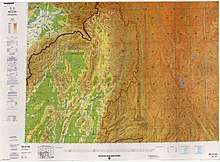
Dehong stretches 122 km (76 mi) from east to west and 170 km (110 mi) from north to south, and its area is 11,526 km2 (4,450 sq mi).
Demographics
The population of Dehong in 2003 was 1.02 million, 48.17% of whom were Han Chinese, 51.83% were national minorities, mostly Dai and Jingpo.
Climate
| Month | Jan | Feb | Mar | Apr | May | Jun | Jul | Aug | Sep | Oct | Nov | Dec | Year |
|---|---|---|---|---|---|---|---|---|---|---|---|---|---|
| Record high °C (°F) | 27.0 (80.6) |
31.0 (87.8) |
33.4 (92.1) |
35.2 (95.4) |
35.6 (96.1) |
34.9 (94.8) |
34.4 (93.9) |
35.3 (95.5) |
35.0 (95.0) |
33.4 (92.1) |
29.7 (85.5) |
27.4 (81.3) |
35.6 (96.1) |
| Average high °C (°F) | 22.1 (71.8) |
23.9 (75.0) |
27.3 (81.1) |
29.5 (85.1) |
29.5 (85.1) |
28.7 (83.7) |
28.0 (82.4) |
29.0 (84.2) |
29.1 (84.4) |
27.8 (82.0) |
25.0 (77.0) |
22.4 (72.3) |
26.9 (80.3) |
| Daily mean °C (°F) | 12.6 (54.7) |
14.5 (58.1) |
17.9 (64.2) |
21.1 (70.0) |
23.3 (73.9) |
24.2 (75.6) |
23.9 (75.0) |
24.2 (75.6) |
23.5 (74.3) |
21.5 (70.7) |
17.3 (63.1) |
13.7 (56.7) |
19.8 (67.7) |
| Average low °C (°F) | 6.1 (43.0) |
7.7 (45.9) |
10.7 (51.3) |
14.7 (58.5) |
18.7 (65.7) |
21.4 (70.5) |
21.5 (70.7) |
21.5 (70.7) |
20.4 (68.7) |
17.8 (64.0) |
12.5 (54.5) |
8.1 (46.6) |
15.1 (59.2) |
| Record low °C (°F) | −0.2 (31.6) |
1.5 (34.7) |
3.6 (38.5) |
7.5 (45.5) |
13.2 (55.8) |
16.8 (62.2) |
15.9 (60.6) |
17.6 (63.7) |
14.5 (58.1) |
9.3 (48.7) |
5.5 (41.9) |
1.0 (33.8) |
−0.2 (31.6) |
| Average precipitation mm (inches) | 13.7 (0.54) |
26.6 (1.05) |
26.9 (1.06) |
65.4 (2.57) |
154.3 (6.07) |
287.5 (11.32) |
360.1 (14.18) |
317.7 (12.51) |
187.0 (7.36) |
137.9 (5.43) |
49.8 (1.96) |
11.8 (0.46) |
1,638.7 (64.51) |
| Average relative humidity (%) | 78 | 72 | 66 | 67 | 75 | 84 | 87 | 86 | 84 | 83 | 82 | 81 | 79 |
| Source: China Meteorological Data Service Center | |||||||||||||
Administration
Dehong is divided into three counties and two county level cities:
| Map | |||||
|---|---|---|---|---|---|
| Name | Hanzi | Hanyu Pinyin | Population (2010) | Area (km²) | Density (/km²) |
| Mangshi City | 芒市 | Máng Shì | 389,891 | 2,987 | 131 |
| Ruili City | 瑞丽市 | Ruìlì Shì | 180,627 | 1,020 | 177 |
| Lianghe County | 梁河县 | Liánghé Xiàn | 154,175 | 1,159 | 133 |
| Yingjiang County | 盈江县 | Yíngjiāng Xiàn | 305,167 | 4,429 | 69 |
| Longchuan County | 陇川县 | Lǒngchuān Xiàn | 181,580 | 1,931 | 94 |
The prefectural government seat is Mangshi.
Economy
Dehong is one of the 3 primary regions for coffee cultivation in Yunnan. The main coffee planter and processor is Hogood Coffee, which operates a contracting scheme with local farmers.[40] Hogood contracts farm land from smallholders on which it plants seedlings, and then re-contracts with farmers to purchase the coffee beans at harvest.[40]
Further reading
- Luo, Yongxian. A Grammar of Dehong, Southwest China. Canberra, ACT: Pacific Linguistics, Research School of Pacific and Asian Studies, Australian National University, 1999. ISBN 0-85883-496-0
Notes
- The convention in English language named Convention between China and Great Britain giving effect to Article Ⅲ of the Convention of 24 July 1886 relative to Burmah and Thibet, and in Chinese language named 《续议滇缅界、商务条款》
- The agreement in English language named Agreement between China and Great Britain Modifying the Convention of 1 March 1894 relative to Burmah and Thibet, and in Chinese language named 《续议缅甸条约附款》
References
- 卫岗 简历 [Curriculum vitae of Wei Gang]. people.com.cn (in Chinese). People's Daily Online, local government leader database. Retrieved 2018-08-16.
- 王俊强 简历 [Curriculum vitae of Wang Junqiang]. people.com.cn (in Chinese). People's Daily Online, local government leader database. Retrieved 2018-08-16.
- Li Cheng (李赪) (2012). 《云南统计年鉴2017》 [Statistical Yearbook of Yunnan 2017] (in Chinese). Beijing: China Statistics Press. ISBN 978-7-5037-8267-1.
- 德宏傣族景颇族自治州志编纂委员会 (1994). 《德宏州志·综合卷》 [Annals of Dehong Prefecture · Integrated Volume] (in Chinese). Mangshi: Dehong Nationalities Publishing House. ISBN 7-8052-5248-3.
- Luo Jinzhong (罗进忠) (2012). 《云南省2010年人口普查资料》 [People Census Reference of Yunnan 2010] (in Chinese). Beijing: China Statistics Press. ISBN 978-7-5037-6548-3.
- Executive chief editor: Tian Qiyun (田启云); 德宏傣族景颇族自治州志编纂委员会 (2017). 《德宏年鉴2017》 [Yearbook of Dehong 2017] (in Chinese). Mangshi: Dehong Nationalities Publishing House. ISBN 978-7-5558-0726-1.
- Niu Ruchen (牛汝辰) (2016). 《中国地名掌故词典》 [Dictionary of etymology of Chinese places name] (in Chinese). Beijing: China Social Publisher. ISBN 978-7-5087-5238-9.
- Records of the Grand Historian - volume 123, Annals of Dayuan, Wikisource (in Chinese)
- Lou, Zichang (2006). 论古代滇越并非腾越——兼论滇越国不是傣族先民建立的国家 [The Ancient Dianyue Kingdom neither Tengyue Kingdom nor Found by the Dai People——The Ancient Dianyue Kingdom was not Founded by the Dai People]. Journal of Wenshan Teachers College (in Chinese). 19 (3): 40–44. doi:10.3969/j.issn.1674-9200.2006.03.009.
- Chronicles of Huayang - volume 4, Annals of Nanzhong, Wikisource (in Chinese)
- Lou, Zichang (2007). 古代哀牢国的疆域范围和民族构成再探 [Further Study on the Border and Constitute of Ancient Ailao Country]. Journal of Wenshan Teachers College (in Chinese). 20 (1): 38–43. doi:10.3969/j.issn.1674-9200.2007.01.007.
- Xiao, Zhengwei (2010). 哀牢国与滇国、滇越国之辨析 [Ailao Country, Dian Country and Dianye Country]. Journal of Baoshan University (in Chinese) (1): 18–23. doi:10.3969/j.issn.1674-9340.2010.01.004.
- Book of the Later Han - volume 86, Annals of Nanman and Xinanyi, Wikisource (in Chinese)
- Shi Weile (史为乐) (2005). 《中国历史地名大辞典》 [Dictionary of Chinese history places name] (in Chinese). Beijing: China Social Science Press. ISBN 7-5004-4929-1.
- 德宏州政协文史和学习委 (1997). 《德宏州文史资料选辑 第十辑(德宏土司专辑)》 [Compilation of History Reference of Dehong Prefecture - 10th volume (Dehong Tusi volume)] (in Chinese). Mangshi: Dehong Nationalities Publishing House. ISBN 7-80525-340-4.
- 瑞丽市委宣传部 (2007). 《勐卯弄王国》 [Kingdom of Mong Mao] (in Chinese). Mangshi: Dehong Nationalities Publishing House. ISBN 978-7-80750-070-4.
- Yang, Yongsheng (1995). “乘象国滇越”考 [Research of "Dianyue Chengxiang"]. The Ideological Front (in Chinese) (1): 88–91.
- He, Ping (2007). 傣族历史上并没有一个“达光王国”——与杨永生先生商榷 [There was not a Kingdom of Daguang in the History of the Dai Nationality: A Discussion with Mr. Yang Yongsheng]. Ethno-National Studies (in Chinese) (6): 79–88, 109. doi:10.3969/j.issn.0256-1891.2007.06.011.
- He, Ping (2005). 傣族历史上并没有一个"果占璧王国" [There Existed no "Guozhanbi Kingdom" in Dai History]. Thinking (in Chinese). 31 (6): 54–57. doi:10.3969/j.issn.1001-778X.2005.06.011.
- Duan Yuming (段玉明) (2003). 《大理国史》 [History of Dali Kingdom] (in Chinese). Kunming: Yunnan Nationalities Publishing House. ISBN 7-5367-2480-2.
- Stephen G. Haw (2006). Marco Polo's China: A Venetian in the Realm of Khubilai Khan. New York: Routledge. ISBN 9-78-0-415-34850-8.
- Yu Dingbang (余定邦) (2000). 《中缅关系史》 [History of China–Myanmar relations] (in Chinese). Beijing: Guangming Daily Press. ISBN 978-7-8014-5354-9.
- He, Ping (2004). 德宏傣族的西迁与印度阿洪姆人的形成 [The Westward Immigration of Dai People from Dehong and the Coming-into-Being of the Ahoms in Northeastern India]. Social Sciences in Yunnan (in Chinese) (2): 76–81. doi:10.3969/j.issn.1000-8691.2004.02.019.
- Gao, Jinhe (2014). 麓川思氏王国的历史兴衰 [The Rise and Fall of Luchuan Kingdom during the Sis' Reign]. Journal of Lincang Teachers' College (in Chinese). 23 (3): 19–23, 35.
- Lu, Ren (2008). 元代西南边疆与麓川势力兴起的地缘政治 [The Yuan Dynasty's Southwest Frontier and The Geopolitics of the Rise of Luchuan Power]. China's Borderland History and Geography Studies (in Chinese). 18 (3): 55–65, 149.
- Bi, Aonan (2005). 洪武年间明朝与麓川王国关系考察 [A Review on the Relationship between Ming Dynasty and Luchuan Kingdom in the Hongwu Period]. China's Borderland History and Geography Studies (in Chinese). 15 (2): 102–111, 148–149. doi:10.3969/j.issn.1002-6800.2005.02.012.
- Li, Zhengting (2008). "析麓川地"与明代西南边疆变迁关系析评 [The Review of Relation of "Separated the Area of Luchuan" and the Changed of Southwest Borderland of Ming Dynasty]. Thinking (in Chinese). 34 (1): 125–126. doi:10.3969/j.issn.1001-778X.2008.01.028.
- 云南省瑞丽市志编纂委员会 (1996). 《瑞丽市志》 [Annals of Ruili City] (in Chinese). Chengdu: Sichuan Lexicographical Press. ISBN 7-80543-518-9.
- 云南省陇川县志编纂委员会 (2005). 《陇川县志》 [Annals of Longchuan County] (in Chinese). Kunming: Yunnan Nationalities Publishing House. ISBN 7-5367-3082-9.
- 云南省梁河县志编纂委员会 (1993). 《梁河县志》 [Annals of Lianghe County] (in Chinese). Kunming: Yunnan people's Publishing House. ISBN 7-222-01147-1.
- 盈江县志编纂委员会 (1997). 《盈江县志》 [Annals of Yingjiang County] (in Chinese). Kunming: Yunnan Nationalities Publishing House. ISBN 7-5367-1492-0.
- 云南省潞西县志编纂委员会 (1993). 《潞西县志》 [Annals of Luxi County] (in Chinese). Kunming: Yunnan Education Publishing House. ISBN 7-5415-0685-0.
- Zhu, Zhaohua (2004). 薛福成与滇缅边界谈判再研究 [A Reappraisal of Xue Fucheng and the Negotiations of the Boundary of China's Yunnan Province and Burma]. China's Borderland History and Geography Studies (in Chinese). 14 (1): 43–51. doi:10.3969/j.issn.1002-6800.2004.01.005.
- Bruce Elleman; Stephen Kotkin; Clive Schofield (2013). Beijing's Power and China's Borders: Twenty Neighbors in Asia. New York: M. E. Sharpe. ISBN 978-0765627643.
- Wang Tieya (1993). 《中外舊約章彙編》 [Compilation of China-Foreign Countries Former Treaty] (in Chinese). Beijing: SDX Joint Publishing Company.
- Feng, Yue (2014). 中缅边界问题解决的历史过程(1954-1961) [Historical Process of Settling the Sino-Myanmar Boundary Issue]. Southeast Asian Affairs (in Chinese) (3): 23–40. doi:10.3969/j.issn.1003-9856.2014.03.004.
- Jia Guoxiong (贾国雄) (2000). 抗战时期滇缅公路的修建及运输述论 [On Construction and Employment of Yunnan-Burma Road During the Anti-Japanese War]. Journal of Sichuan Normal University(Social Sciences Edition) (in Chinese). 27 (2): 100–105. doi:10.3969/j.issn.1000-5315.2000.02.017.
- Ma Xiangdong (马向东) (1996). 中央垒允飞机制造厂始末 [The Beginning and End of Central Loiwing Aircraft Manufacturing Company]. The Journal of Studies of China's Resistance War Against Japan (in Chinese) (2): 95–102.
- "China Footprint: Large scale farming leads to high productivity in China". CGTN. September 6, 2017.
External links
| Wikimedia Commons has media related to Dehong Dai and Jingpo Autonomous Prefecture. |
- Dehong local government site (in Chinese)
- Dehong tuanjie bao (magazine in Chinese)
- Dehong (from Xinhuanet.com, in Chinese)
